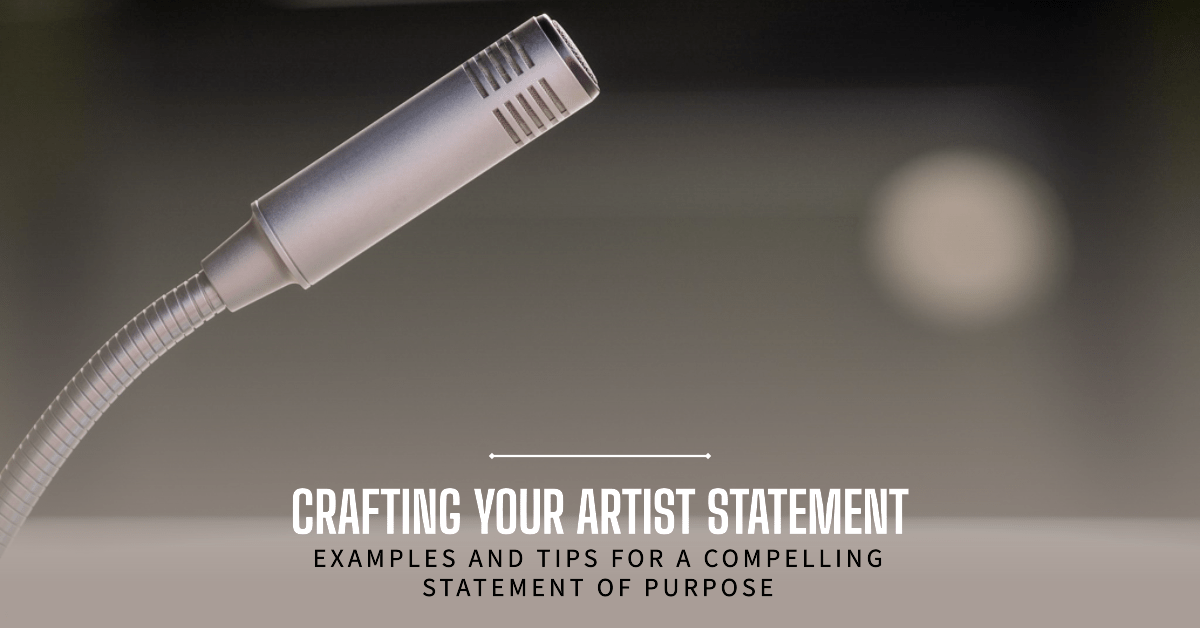29 September 2023
6 minutes read
Artist Statement of Purpose Examples: Crafting Your Fine Art Personal Statement

When it comes to pursuing a career in fine art, a well-crafted artist statement of purpose can be your ticket to success. Whether you’re applying for an MFA, BFA, or a position in the art world, your personal statement holds the key to showcasing your passion, creativity, and dedication.
In this comprehensive guide, we will dive deep into artist statement of purpose examples, helping you understand how to articulate your love for art effectively and create a compelling personal statement.
Worried about the cost of Studying Abroad?
Sign up to access 25 game-changing scholarships that could cover your costs.

The Importance of a Personal Statement
Your personal statement, often interchangeably referred to as a statement of purpose (SOP), is your opportunity to tell your unique story as an artist. It allows admissions committees or potential employers to get to know you beyond your portfolio or resume.
Your personal statement should convey your artistic journey, influences, experiences, and future aspirations. It’s a chance to make a lasting impression and demonstrate why you are a perfect fit for your chosen fine art program or career in the art world.
Stuck on How to Pick Your Ideal College?
Sign up to access your tailored shortlist and simplify finding your ideal college.

Crafting a Captivating Introduction
Personal Statement
Your personal statement should begin with a captivating introduction that immediately grabs the reader’s attention. Think of it as the opening scene in a captivating movie. Here’s an example:
“Art has always been my muse, guiding my life’s path towards creative expression. From the moment I held a paintbrush, I knew that art was more than just colors on a canvas; it was a form of storytelling, a means to connect with the world and express the deepest facets of my being.”
Expressing Your Love for Fine Art
Your introduction should convey your deep-seated love for fine art. You can talk about when and how your passion for art first ignited. Maybe it was a childhood memory of visiting an art museum, or perhaps you had an inspiring art teacher who encouraged your creativity. Sharing this personal connection with art can draw readers into your narrative.
Defining Your Artistic Identity
In the introduction, you should also touch upon what makes your artistic identity unique. What sets you apart as an artist? Do you have a signature style, technique, or theme that defines your work? This is the time to provide a glimpse into what makes your art special.
See how Successful Applications Look Like!
Access 350K+ profiles of students who got in. See what you can improve in your own application!

Sharing Concrete Examples of Your Work and Experiences
Statement Examples
Once you’ve captured your reader’s attention with a compelling introduction, it’s time to delve into the heart of your personal statement by sharing concrete examples of your work and experiences. This section should showcase your artistic journey and demonstrate your dedication to your craft.
Highlighting Artistic Milestones
In this section, you can mention significant milestones in your artistic journey. These could include exhibitions, awards, or collaborations that have shaped your development as an artist. For instance:
“Over the years, I have had the privilege of showcasing my work in prestigious galleries and museums, such as the Tate Modern in London. These opportunities not only exposed my art to a wider audience but also pushed me to constantly evolve as an artist.”
By highlighting these achievements, you demonstrate your commitment to your art and your ability to thrive in the competitive art world.
Discussing Artistic Influences
Artists are often inspired by the work of others. Share the artists or artworks that have influenced your creative process. You might mention famous painters, sculptors, or contemporary artists whose work resonates with you. Explaining how these influences have shaped your artistic perspective can provide insight into your unique approach to art.
Detailing Your Educational Background
If you’ve pursued formal education in fine art, whether it’s an undergraduate degree, a BFA, or an MFA, this is the place to discuss it. Talk about your academic journey, the courses that had a profound impact on you, and any mentors who guided your artistic growth. Be sure to convey how your education has contributed to your development as an artist.

Start Your University Applications with Ambitio Pro!
Get Ambitio Pro!
Begin your journey to top universities with Ambitio Pro. Our premium platform offers you tools and support needed to craft standout applications.
Unlock Advanced Features for a More Comprehensive Application Experience!

Start your Journey today

Start your Journey today
Exploring Specific Interests and Influences
Art and Design Personal Statement
Art is a vast and diverse field, and this section allows you to explore your specific interests and influences in greater detail. Whether you’re passionate about painting, sculpture, graphic design, or any other art form, here’s where you can delve into the heart of your creative focus.
Passion for a Specific Art Form
Share your deep-seated passion for your chosen art form. Explain why you are drawn to it and how it allows you to express yourself. For example:
“My fascination with seascapes and the fragility of nature has been a recurring theme in my work. It’s a subject that allows me to explore the vastness and immensity of the natural world while conveying its fragility.”
Artistic Inspirations
Discuss the artists or movements that have had a profound impact on your work within your chosen art form. Whether it’s the abstract expressionism of Jackson Pollock or the precision of Renaissance art, detailing these influences adds depth to your personal statement.
Your Creative Process
Take the reader on a journey through your creative process. How do you approach your work? Do you start with sketches, embrace spontaneity, or meticulously plan each piece? Sharing your process can provide insight into your artistic mindset.
Stuck on How to Pick Your Ideal College?
Sign up to access your tailored shortlist and simplify finding your ideal college.

Articulating Your Goals and Aspirations
Fine Art Personal Statement
Your personal statement should not only reflect on your past but also look to the future. What are your artistic goals and aspirations? Where do you see yourself in the art world? This section allows you to articulate your vision and ambition as an artist.
Short-Term Goals
Discuss your immediate goals within the art world. Whether it’s participating in specific exhibitions, collaborating with fellow artists, or mastering a new technique, these short-term objectives reveal your drive and commitment.
Long-Term Aspirations
Take a broader view and share your long-term aspirations. Do you dream of curating your own gallery, teaching art to the next generation, or becoming an internationally recognized artist? Expressing these ambitions paints a vivid picture of your future in the art world.
Why This Program or Career?
If you’re applying to a specific program, be it an MFA or a job opportunity, explain why it’s the perfect fit for your artistic journey. Mention how the program’s curriculum, faculty, or mission align with your goals.
Tailoring Your Statement for MFA and BFA Applications
MFA and BFA
Depending on whether you’re applying for a Master of Fine Arts (MFA) or a Bachelor of Fine Arts (BFA) program, there are specific elements to emphasize in your personal statement.
MFA Program Emphasis
For MFA applicants, emphasize your commitment to furthering your craft and the advanced level of artistry you bring to the table. Discuss your readiness for the intensive program and your eagerness to engage in critical discourse with fellow artists.
“Enrolling in the MFA program at [University Name] is a natural step in my journey to become a professional artist. I am ready to immerse myself in a community of dedicated artists, engage in rigorous critiques, and push the boundaries of my creative practice.”
BFA Program Emphasis
Similarly, BFA applicants should convey their passion and readiness to embark on their educational journey. Highlight your enthusiasm for learning and your willingness to explore various aspects of fine art.
“I am eager to embark on the BFA program, where I can continue to refine my graphic design and photography skills. This program’s focus on nurturing emerging artists aligns perfectly with my goals of honing my craft and exploring new artistic horizons.”
Showcasing Your Love for Art History
Art History
For those with a passion for art history, your personal statement should reflect your deep love for the subject and your desire to explore its intricacies.
Unearthing Art Historical Insights
Share your favorite periods, artists, or art movements within the scope of art history. Discuss why you find these aspects particularly fascinating and how they have influenced your perspective.
“Art history has been my guiding light in understanding the evolution of artistic expression. I am particularly captivated by the Romantic period and its emphasis on emotion, individualism, and nature, as seen in the works of artists like Caspar David Friedrich.”
Academic Pursuits
If you’re applying for graduate studies in art history, discuss your academic interests and the areas of art history you wish to explore further. Mention any research projects, papers, or presentations that showcase your dedication to the field.
“During my undergraduate studies, I delved into the complexities of American art history. My thesis on the impact of Abstract Expressionism on post-war American society was a testament to my commitment to scholarly pursuits in this field.”
Conclusion: Crafting Your Artistic Narrative
Crafting a compelling artist statement of purpose is an art form in itself. By drawing inspiration from these examples and infusing your personal experiences, you can create a statement that reflects your passion for fine art.
Remember, your personal statement is your opportunity to shine and convey why you are a perfect fit for your chosen fine art program or career in the art world.
In closing, let your personal statement be a testament to your love for art and your unwavering commitment to the world of creativity. Use it as a canvas to paint your story, one brushstroke at a time, and let your passion shine through every word. Your artistic journey begins with your statement of purpose, so make it a masterpiece.
With this comprehensive guide, you now have the tools and inspiration to craft a personal statement that leaves a lasting impression and sets you on a path toward success in the world of fine art. Embrace your creativity, share your story, and let your love for art guide you on this incredible artistic journey.
FAQs
What should I include in my artist statement of purpose?
Your statement should cover your artistic journey, influences, experiences, and future aspirations. Use concrete examples to illustrate your passion for fine art.
How long should my personal statement be?
Aim for a concise statement, typically around 500-800 words. Be sure to follow any specific word limit guidelines provided by the institution or program.
Can I use samples of my work in my statement?
Absolutely! Including images or descriptions of your work can add depth to your statement and showcase your artistic abilities.
Should I mention specific artists or artworks that inspire me?
Yes, mentioning artists or artworks that have influenced you can provide insight into your artistic perspective and passion.
How important is the artist statement in the application process?
Your personal statement is a crucial component of your application. It allows admissions committees to understand your unique voice, passion, and suitability for their program.
Table of Contents
- •The Importance of a Personal Statement
- •Crafting a Captivating Introduction
- •Sharing Concrete Examples of Your Work and Experiences
- •Exploring Specific Interests and Influences
- •Articulating Your Goals and Aspirations
- •Tailoring Your Statement for MFA and BFA Applications
- •Showcasing Your Love for Art History
- •Conclusion: Crafting Your Artistic Narrative
- •FAQs

Almost there!
Just enter your OTP, and your planner will be on its way!
Code sent on
Resend OTP (30s)

Your Handbook Is Waiting on WhatsApp!
Please have a look, and always feel free to reach out for any detailed guidance
or
Click here to download
Meanwhile check out your dashboard to access various tools to help you in your study abroad journey

Get Ambitio Pro!
Unlock Advanced Features for a More Comprehensive Application Experience!

Start your Journey today
Find your Dream school now⭐️



Almost there!
Just enter your OTP, and your planner will be on its way!
Code sent on
Resend OTP (30s)














 Ambitio Pro
Ambitio Pro
 Ambitio Elite
Ambitio Elite























